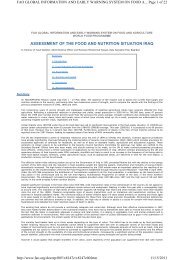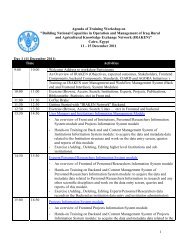Vermiculture in Egypt: - FAO - Regional Office for the Near East and
Vermiculture in Egypt: - FAO - Regional Office for the Near East and
Vermiculture in Egypt: - FAO - Regional Office for the Near East and
Create successful ePaper yourself
Turn your PDF publications into a flip-book with our unique Google optimized e-Paper software.
<strong>the</strong> cost of fish-keep<strong>in</strong>g, but also better results of that culture (Kostecka <strong>and</strong> Paczka,<br />
2006).<br />
Three meals were <strong>for</strong>mulated from <strong>the</strong> earthworm (Endrilus eug<strong>in</strong>eae) <strong>and</strong> maggot<br />
(Musca domestica) <strong>and</strong> fish (Engraulis encrosicolus). These meals were evaluated as<br />
a potential replacement <strong>for</strong> fishmeal. This is because fishmeal could be very<br />
expensive at times. The three meals were used <strong>in</strong> feed<strong>in</strong>g <strong>the</strong> catfish (Heterobranchus<br />
isopterus) <strong>for</strong> 30 days. On <strong>the</strong> basis of weight <strong>in</strong>crement, <strong>the</strong> best growth per<strong>for</strong>mance<br />
was produced by maggot meal. It was followed by earthworm <strong>and</strong> fish meals,<br />
respectively. Based on food conversion ratio maggot meal was aga<strong>in</strong> <strong>the</strong> best,<br />
followed by earthworm <strong>and</strong> fish meals respectively. The importance of supplementary<br />
feed<strong>in</strong>g was evidenced <strong>in</strong> <strong>the</strong> higher weight <strong>in</strong>crement <strong>in</strong> fish that were fed than those<br />
that were not fed. Maggot <strong>and</strong> earthworm meals could <strong>the</strong>re<strong>for</strong>e be a whole or partial<br />
replacement <strong>for</strong> fishmeal. The difficulty <strong>in</strong> <strong>the</strong> harvest<strong>in</strong>g or rear<strong>in</strong>g maggots <strong>and</strong><br />
earthworms may however reduce this potential (Yaqub, 1991).<br />
The use of vermicompost <strong>in</strong> pisci-culture is ga<strong>in</strong><strong>in</strong>g its <strong>in</strong>creased recognition <strong>for</strong> <strong>the</strong><br />
conservation of energy <strong>and</strong> optimum but economical utilization of available resources<br />
with simultaneous pollution control. Vermicompost is hazard free organic manure,<br />
which improves quality of pond base <strong>and</strong> overly<strong>in</strong>g water as well as provides<br />
organically produced aqua crops. The additions of manures affect <strong>the</strong> relative<br />
abundance of <strong>the</strong> plankton <strong>and</strong> <strong>the</strong>ir community structure <strong>in</strong> aquatic system. Proper<br />
comb<strong>in</strong>ations of <strong>in</strong>organic nutrients (NPK) are <strong>the</strong> major factors that <strong>in</strong>fluence <strong>the</strong><br />
growth <strong>and</strong> production of plankton <strong>in</strong> a pond. Vermicompost conta<strong>in</strong>s all <strong>the</strong> major<br />
organic nutrient components of N, P <strong>and</strong> K along with some necessary micronutrients<br />
<strong>for</strong> plankton growth (Table 6.4).<br />
In aquaculture <strong>in</strong>dustry, capital <strong>in</strong>vestment apart, <strong>the</strong>re are also operat<strong>in</strong>g expenses,<br />
ma<strong>in</strong>ly <strong>for</strong> seed, fertilizer, feed <strong>and</strong> labors. Among those, <strong>the</strong> cost of feed <strong>and</strong><br />
fertilizer constitute about 70% of <strong>the</strong> total expenses. For this reason <strong>the</strong>re is need <strong>for</strong><br />
search<strong>in</strong>g out chapter sources <strong>for</strong> feed <strong>and</strong> fertilizer. So, this is particularly significant<br />
<strong>in</strong> develop<strong>in</strong>g nations, where fish farmers are unable to buy costly fish feed <strong>and</strong><br />
chemical fertilizer vermicompost <strong>for</strong>ms an abundant alternative natural resource <strong>for</strong><br />
less expensive manure <strong>and</strong> fish feed <strong>for</strong> higher fish yield. However, <strong>the</strong> amount of<br />
available nitrogen <strong>and</strong> phosphorus from vermicompost is less when compared with<br />
conventional fertilizers <strong>and</strong> research should be oriented to <strong>in</strong>crease its nitrogen <strong>and</strong><br />
phosphorus concentration through alteration of substrate composition.<br />
Table 6.4. Different nutrient concentration <strong>in</strong> manure <strong>and</strong> fertilizer applied (average<br />
value of triplicate sample analyzed)<br />
Parameters<br />
Available N<br />
(mg·g -1 )<br />
Available P<br />
(mg·g -1 )<br />
Available K<br />
(mg·g -1 )<br />
Dry weight of fertilizer<br />
<strong>and</strong> manure used (g)<br />
Diammonium phosphate (DAP) 18 ± 0.07 46 ± 0.05 Nil 3.04<br />
Vermicompost 1.5 ± 0.05 1.4 ± 0.08 1.0 ± 0.05 99.0<br />
Compost<br />
Souce: Chakrabarty et al, (2009).<br />
1.0 ± 0.08 0.55 ± 0.09 1.0 ± 0.05 252.0<br />
Sample of soil, compost, vermicompost <strong>and</strong> DAP were analyzed <strong>for</strong> available P, N<br />
content as well as <strong>for</strong> organic carbon. The dry weights of <strong>the</strong> fertilizer <strong>and</strong> manure<br />
58





